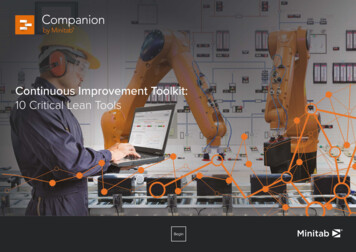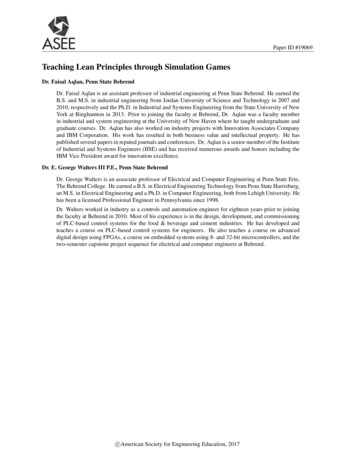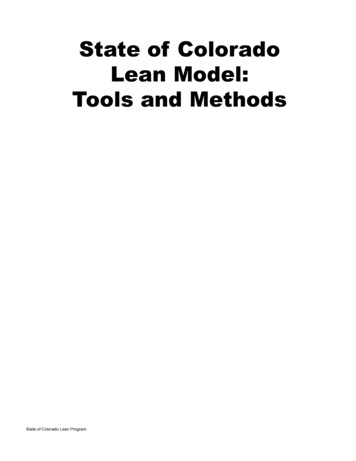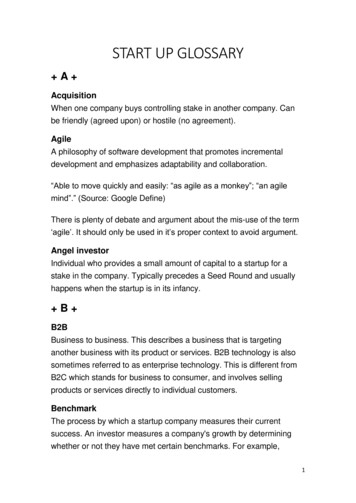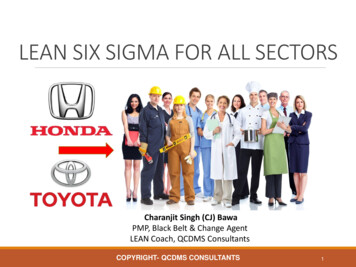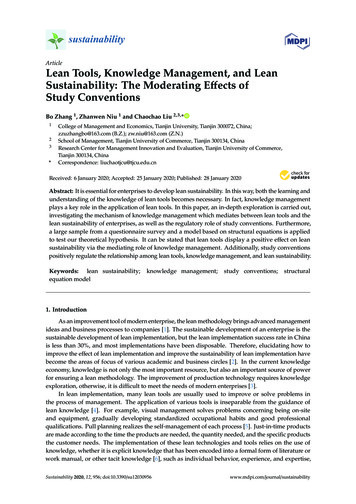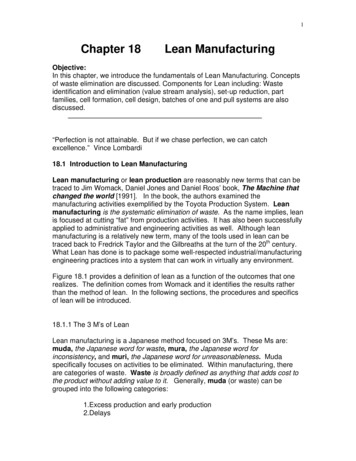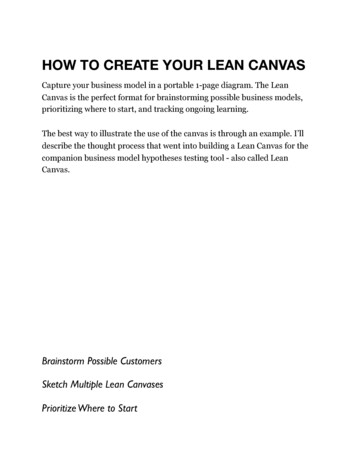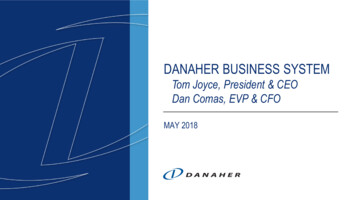
Transcription
Proceedings of the 2016 International Conference on Industrial Engineering and Operations ManagementDetroit, Michigan, USA, September 23-25, 2016Lean Construction ToolsRichard Hannis AnsahFaculty of Industrial Management (FIM)Universiti Malaysia PahangLebuhraya Tun Razak, 26300 Kuantan Pahang, Malaysiarichanisah13@gmail.comShahryar SorooshianFaculty of Industrial Management (FIM)Universiti Malaysia PahangLebuhraya Tun Razak, 26300 Kuantan Pahang, Malaysiasorooshian@gmail.comShariman Bin MustafaFaculty of Industrial Management (FIM)Universiti Malaysia PahangLebuhraya Tun Razak, 26300 Kuantan Pahang, Malaysiashariman@ump.edu.myGomanth DuvvuruA. Leon Linton Department of Mechanical EngineeringLawrence Technological UniversitySouthfield, Michigan, USAgduvvuru@ltu.eduAbstractProduction management is at the center of lean construction (LC) and keeps running from the projectinitiation through project handover to maintenance. Several powerful lean production techniques and toolshave been developed over the past decade to manage construction projects. Some of these are procedural,some are conceptual, and some are embedded in programming. Besides, while some of these tools aresimple, complexities revolves around others, for instance, the last planner system (LPS) is consideredcomplex. This different set of tools is very effective in the hands of managers stimulated by the lean projectconceptualization and management. It has been indicated that Danish contractors had increased productivityby 20%, minimized project duration by 10%, expanded efficiency by 20%, and enhanced profitability 20%- 40% on projects where lean principles are adopted. However, no list would be conclusive and accuratefor long because innovation is in progress and new techniques and tools emerge constantly. In this study,we identify suitable lean construction tools based on their applicability and ability to control delays inMalaysian construction projects. This study provides construction managements with suitable leanconstruction tools to build a realistic and rational lean application guide.KeywordsLean Construction, Lean Tools, Construction Project, Lean Production, Applicability IEOM Society International784
Proceedings of the 2016 International Conference on Industrial Engineering and Operations ManagementDetroit, Michigan, USA, September 23-25, 20161. IntroductionProduction management is at the center of lean construction (LC) and keeps running from the project initiation throughproject handover to maintenance. Lean Production Management (LPM) is keen to managing and reducing uncertaintyand variability in project plans execution. Numerous powerful lean production techniques and tools have beendeveloped over the past decade to manage construction projects. Some of these are procedural, some are conceptual,and some are embedded in programming. While some of these tools are simple, complexities revolve around others,for instance, the last planner system (LPS) is considered complex (Ballard et al., 2000). This different set of tools isvery effective in the hands of managers enlivened through project conceptualization and management. Bertelsen et al.(2001) indicated that Danish contractors had increased productivity by 20%, minimized project duration by 10%,expanded efficiency by 20%, and enhanced profitability 20% - 40% on projects where lean principles are adopted.However, no list would be conclusive and accurate for long because innovation is in progress and new techniques andtools emerge constantly.The recognition of the uncertainty on construction projects as a result of the how projects are managed, rather thanblaming on external sources is an initial step for lean project delivery system (LPDS) and subsequently reducinguncertainty and waste in processes. Project management must utilize and deploy tools, skills, knowledge, techniquesand available resources to facilitate projects to be able to complete projects on time (Glenn, 2007; Sorooshian et al.,2010; Norzima et al., 2011; Saladis and Kerzner, 2011; Sorooshian, 2014).Several techniques and tools have been developed and used in the lean project implementation guideline LPDS. Thisis due to the recognition by construction companies of the possibilities of an effective lean project development processin reducing time to complete new projects (Bashford et al., 2005; Abdelhamid et al., 2008; Sacks et al., 2010; Marhaniet al., 2013; Sarhan and Fox 2013; Muhammad et al., 2013; Nikakhtar et al., 2015), environmental sustainability,design and supply chain management integration, engineering hours, ease of constructability, flexibility, processcontrol, and increased in the quality of new projects (Rahman et al., 2012; Aziz and Hafez, 2013; Muhammad et al.,2013). Nonetheless, the incorporation of the concept of lean thinking into the construction project development processcomes with its own weaknesses and strengths. For most businesses, there is still some uncertainty concerning thesuitable lean tools and its effectiveness. Without suitable lean tools, the improvement and performance of the leanproject development program cannot be achieved and this may lead to poor decision making in the lean projectdevelopment implementation roadmap (Schweikhart and Dembe, 2009; Li, 2011).Also, there has been remarkably little empirical and academic research on the subject addressed in this study and muchof existing lean tools application for construction project delivery are country or project specific, concentrated on leanthinking and barriers that prevent lean implementation (Sacks et al., 2010; Lajevardi et al., 2011; Muhammad et al.,2013; Marhani et al., 2013; Sarhan and Fox 2013; Nikakhtar, et al., 2015) or description of a single, two or few leantools; thereby overlooking other suitable lean tools, whilst others are consultancy approaches, which are partly and insome instances not published. Therefore, there is a need for more empirical research that concentrates on theidentification of suitable lean tools for construction projects. This is because without a clear identification of suitablelean tools reducing delays in the construction industry will be complicated. The interesting point here is about thesuitability or applicability of the lean tools. To deal with the suitability, applicability, and effectiveness of the leantools, this study identifies the applicable and/or suitable lean tools to control waste in Malaysian construction projects.2. Lean Construction ToolsThere is no dought that lean construction is the way forward for construction industries around the world, especiallyMalaysia. About 57% of productive time waste are said to exist in the construction industry (Hannis-Ansah et al.,2016) and this calls for research and the use of robust and radical techniques to solve the problems the industry faces(Lajevardi et al., 2011; Zahidy et al., 2015). The conventional approaches to construction project management haveinadequacies in addressing the challenges in the industry (Ballard and Howell, 1994; Johnston and Brennan, 1996;Koskela, 2000; Koskela and Howell, 2001; Hannis-Ansah et al., 2016). Conversely, lean production management andtechniques provide the foundations for waste minimization or its total elimination from construction projects(Muhammad et al., 2013). One of the most effective approaches for reducing delays in Malaysian construction projectsis through lean tools adoption (Nikakhtar et al., 2015). Even though Malaysian construction industry is still evolving,there is neglect of the benefits of lean tools adoption in the industry (Muhammad et al., 2013). Meanwhile, other IEOM Society International785
Proceedings of the 2016 International Conference on Industrial Engineering and Operations ManagementDetroit, Michigan, USA, September 23-25, 2016industries have been reaping the benefits of using lean tools (Schweikhart and Dembe, 2009; Salimi et al., 2012; Koayand Sorooshian, 2013; Anvari et al., 2014; Alireza and Sorooshian, 2014). Similarly, other construction industrieselsewhere have found lean tools to be effective in delay control (Bashford et al., 2005; Abdelhamid et al., 2008; Sackset al., 2010; Marhani et al., 2013; Sarhan and Fox 2013; Aziz and Hafez, 2013). The Malaysian construction industryis suffering from issues of high delays and low productivity and the only feasible method to cope with this situationis to adopt the lean methodology, and it will be more significant that lean tools are applied by all stakeholders involvedin Malaysian construction industry (Muhammad et al., 2013).In general, lean construction tools are intended to improve the delivery systems and processes by minimizing wastes,increasing productivity and health and safety and overall, achieving client’s requirements (Hannis-Ansah et al., 2016).In essence, it will lead to better delivery processes and value-added systems through the removal of wastes;transportation, overproduction, inappropriate processing, lead time, inventories, rework and unnecessary movementsin construction processes, hence, improve project and financial performance of the industry (Hannis-Ansah et al.,2016). In order to resolve the problems associated with waste in the construction projects, several lean tools have beenrecommended by a few researchers. Among them include Rahman et al. (2012), Muhammad et al. (2013), Aziz andHafez (2013), Burton and Boeder (2003), Hines and Rich (1997) and Evbuomwan and Anumba (1998), Ballard andHowell (1994), Johnston and Brennan (1996), Koskela (2000), Bashford et al. (2005), Sacks et al. (2010), Marhani etal. (2013), Sarhan and Fox (2013), among others. Emphatically, Muhammad et al. (2013) underlined 9 tools for theMalaysian construction industry. Also, Rahman et al. (2012) listed 27 tools to construction practitioners as anintroductory lean implementation guide (see figure 1). Even though these works are worthwhile, however, they lackevidence in their analysis and whether or not these tools are suitable for the context of Malaysian construction projectsis subjective.Figure 1: Waste Management FrameworkIn confirmation of the literature gap and how to fill this gap, this paper through comprehensive literature identifiessome suitable lean tools for further empirical inquiry in the context of construction project development.No.1ReferenceAlireza andSorooshian (2014),Rahman et al.(2012), Muhammadet al. (2013)Table 1: Lean Construction ToolsToolsDescription5SStands for Seiri, Seiso, seiton, Seiketsu and Shitsuke,(meaning Sort, Straighten, Shine, Standardize, and Sustain).This is a process for waste removal from the workplacethrough the use of visual controls. IEOM Society International786
Proceedings of the 2016 International Conference on Industrial Engineering and Operations ManagementDetroit, Michigan, USA, September 23-25, 20162Aziz and Hafez(2013), Rahman etal. (2012)ConcurrentEngineering2ASQ (2015),Rahman et al.(2012)Check Sheet4Lee et al. (1999),Rahman et al.(2012)ConstructionProcess Analysis5Alireza andSorooshian (2014),Rahman et al.(2012)ASQ (2015),Rahman et al.(2012)Alireza andSorooshian (2014),Rahman et al.(2012)ASQ (2015),Rahman et al.(2012)Six SigmaAziz and Hafe,(2013), Alireza andSorooshian (2014)Alireza andSorooshian (2014)Alireza andSorooshian (2014)Continuous Flow12Rahman et al.(2012), Alireza andSorooshian (2014)Kanban (PullSystem)13Alireza andSorooshian (2014)Kaizen14Rahman et al.(2012), MuhammadThe Last Planner67891011Pareto AnalysisCheck Points andControl PointsFailure Mode andEffects Analysis(FMEA)FIFO line (First In,First Out)Jidoka/AutomationThis methodology involves the various tasks parallellyexecuted multi-disciplinary teams with the aim of optimizingengineering cycles of products for efficiency, quality, andfunctionality.Also known as Defect Concentration Diagram. This is astructured form prepared for collecting and analyzing data. Itis a generic tool adapted for a variety of purposes includingobservation and a collection of data on the frequency ofpatterns of problems, events, defects, causes, etc.This actualizes process charts and top-view flow chartscommon among process analysis methods. These diagramsand charts depend on standardized symbols and effectivelydescribe process flow and enable a quick determination ofareas where problems exist in the process. The chartscomprise of six symbols; Operation, Storage, Transportation,Volume Inspection, Delay, and Quality Inspection. Theprocess diagram records every progression or step of aconstruction operation. Furthermore, it records flow withinunits, sections, and departmentsSets of tools and techniques for improving quality throughidentification and removal of defects and reduction ofvariability in processes. Six Sigma is able to achieve processquality of 99.99966% that is free from defects.This is a bar graph that is used for analyzing data about thefrequency of the causes or problems in processes. It visuallydepicts which situation are more important.These are mechanisms used to regulate and determine thelevels of improvement in the activities of managers occupyingdifferent levels of positionsThis is a step by step approach for identifying potentialfailures in product or service, design, and manufacturing, etc.The failures are further ranked to determine the seriousness oftheir consequences in order to take actions to eliminate them,starting with the highest ranked ones.This means to constantly provide or process and producethrough a progressive system of uninterrupted steps in theprocess.This is an approach for handling work request in order of flowfrom first to the last.The purpose of Jidoka is to design machines to partiallyautomate the manufacturing process and operations in orderto separate people from machines so that operators carry outother task(s) while the machines are running.This is a Japanese word which literally means “billboard orsignboard”. It is an information control process whichregulates the movements or flow of resources so that parts andsupplies are ordered and released as they are needed.This is Japanese business philosophy for continuousimprovement. This is an approach that seeks to improvequality and efficiency through the elimination of waste fromthe value stream.The last planner is a person or group of people with the taskto control production unit. They are responsible necessitating IEOM Society International787
Proceedings of the 2016 International Conference on Industrial Engineering and Operations ManagementDetroit, Michigan, USA, September 23-25, 201615et al. (2013), Azizand Hafez (2013)Alireza andSorooshian (2014)Heijunka (LevelScheduling)Muhammad et al.(2013), Alireza andSorooshian (2014)Salem et al. (2005),Rahman et al.(2012), Muhammadet al. (2013)Poka-Yoke (ErrorProofing)18Alireza andSorooshian (2014)Time and MotionStudy19Rahman et al.(2012),LeanProduction.Com (2015Alireza andSorooshian (2014)Rahman et al.(2012), Muhammadet al. (2013),Alireza andSorooshian (2014)Alireza andSorooshian (2014)Tsao et al. (2004),Rahman et al.(2012)Bottleneck Analysis25Alireza andSorooshian (2014)Tsao et al. (2004),Muhammad et al.(2013)Multi-ProcessHandling5 Whys26Salem et al. (2005)Fail Safe for Quality16172021222324First Run Studiescontrol of workflow, verify supply stream, design, andinstallation in all the production units.This is an evenly spreading of production for customer ordersby looking at the average demand and combining them into aproduction schedule that takes into consideration the volumeand mix.This is a mechanism design to detect and prevent errors inprocesses with the aim of achieving zero defects.Trial execution of a process with a specific end goal to decidethe best means, strategies, sequencing, among others toperform it. First run studies are done a couple of weeks aheadof the scheduled execution of the process, in order to securesome time to acquire diverse or extra essentials and resources.In construction, this is used for redesigning criticalassignments. This is part of continuous improvement effort,and incorporate efficiency studies and review worktechniques by redesigning and streamlining the distinctivefunctions involved. The techniques involve the use ofphotographs, video files or graphics to demonstrate theprocess.A procedure for evaluating industrial or other operationalefficiency on the basis of the taken or needed time for anoperation or production.This is the identification of the part of the process that put alimitation on the overall productivity in order to improve theperformance of that part.Total ProductiveMaintenance (TPM)Visual ManagementThis is a holistic maintenance approach for equipment in orderto maximize the operational time of the equipment.This is information communication technique employ toincrease efficiency and clarity in processes through the use ofvisual signals.Synchronize/LineBalancingWork StructuringThis involves leveling of workload across all processes in avalue stream to remove excess capacity and bottlenecks.This is used for the development of process design andoperation in alignment with the supply chain structure,allocation of resources, product design, and assembly designefforts with the objective of making work process morereliable and quick while delivering quality to the client.This involves assigning operators tasks in multiple processesin an oriented layout of a product flow.This is a quality management tool for problem-solving and ittries to find the root cause of an issue. It stipulates thatworkers should be asking why five times repeatedly until theyidentify the underlying root or the nature of the issue and itssolution becomes clear. The procedure tries to fix a system byeliminating the root cause to avoid its recurrenceThis relies on the generation of ideas which alert for potentialdefects. This is almost the same as Poka-Yoke techniques butit can be extended to safety. However, the concentration insafety is on potential hazards rather than potential defects, and IEOM Society International788
Proceedings of the 2016 International Conference on Industrial Engineering and Operations ManagementDetroit, Michigan, USA, September 23-25, 201627Salem et al. (2005),Muhammad et al.(2013)Daily HuddleMeetings28Alireza andSorooshian (2014)PreventiveMaintenance29Alireza andSorooshian (2014)Quality FunctionDevelopment (QFD)30Leanproduction.Com (2015)Leanproduction.Com (2015)SMART Goals32Alireza andSorooshian (2014)Setup Reduction33Muhammad et al.(2013), Alireza andSorooshian (2014)Alireza andSorooshian (2014)WorkStandardization35Alireza andSorooshian (2014)Suggestion schemes36Rahman et al.(2012), Muhammadet al. (2013), Azizand Hafez (2013),Alireza andSorooshian (2014)Alireza andSorooshian (2014)Rahman et al.(2012), ASQ(2015)Just-in-Time (JIT)Rahman et al.(2012),Leanproduction.Com (2015)Leanproduction.Com (2015)Value StreamMapping313437383940PDCA (Plan, Do,Check, Act)Statistical ProcessControlTeam PreparationMuda WalkRoot CauseAnalysisit is identified with the risk assessment technique. It requiresaction plan that avoids bad outcomesThis a technique used for communicating and for everydaymeeting process of the project team in order to accomplishworkers involvement. With project awareness and problemsolving contribution alongside some training that is given bydifferent tools, the satisfaction of job (sense of growth, selfesteem,) will increase.This is regular maintenance performed on equipment toreduce the probability of its failure. It is usually performedwhile the equipment is working to avoid unexpectedbreakdown.This refers the use of customer's voice and differentorganization functions and units for final engineeringspecification of a product.Goals that are Specific, Measurable, Attainable, Relevant, andTime-Specific.This is an iterative approach for improvementsimplementation. It involves; Plan (set up a plan and expectresults); Do (execute the plan); Check (verify anticipatedresult achieved); and Act (evaluate; do it again).This is a changeover technique use to speedily change toolsand fixtures in order for multiple products to be run on thesame machine.Manufacturing documented procedures that capture bestpractices. This “living” documentation that is easy to change.This is a quality control tool that monitors and control processin order to ensure that system output variables operate to itsfull potential through periodic measurement.This is a formal mechanism which allows and encouragesemployees to actively contribute productive ideas for productand process improvements.This is a technique aimed primarily at minimizing flow timeswithin a production as well as response times from suppliersand to end users. In any case, JIT is a way of thinking, workingand managing to eliminate wastes in processes.This is a process of conducting training on waste, continuousflow and standardizes work for the lean team or employees.Muda is a Japanese word meaning waste. Muda walk is atechnique used to identify waste through observation ofoperations, how work processes are conducted, and notingareas where improvements are needed.A technique for visually analyzing, documenting andimproving the flow of a process in a way that highlightsimprovement opportunities.This is a problem-solving technique that focuses ondiscovering and resolving the real problem instead of quickfix application that only solve problem symptoms. IEOM Society International789
Proceedings of the 2016 International Conference on Industrial Engineering and Operations ManagementDetroit, Michigan, USA, September 23-25, 20163. Results and DiscussionsAn extensive synthesis of literature was conducted and 40 lean tools were identified in the construction projectenvironment. After literature screening, an interview which attempts to extend the quantitative data was undertakenwith experts, who are managers at the Construction Research Institute of Malaysian (CREAM) to confirm thesuitability and/or applicability of the lean tools in relation to the Malaysian construction industry. Following theinterview, only 30 lean tools were endorsed as being effective and suitable for the industry. An interview approachwas used to ensure that the experts provide a reliable and comparable assessment. The list of the endorsed tools hasbeen presented in Table 282930Table 2: Suitable Lean Construction ToolsLean ToolLast Planner System (LPS)Concurrent EngineeringDaily Huddle Meetings5SFirst Run StudiesVisual ManagementFail Safe for QualityConstruction Process AnalysisKanban (Pull System)Just-In-TimeWork StandardizationValue Stream MappingStatistical Process Control (SPC)Work StructuringPareto AnalysisPoka-Yoke (Error Proofing)Continuous FlowSix SigmaFailure Mode and Effects Analysis (FMEA)Bottleneck AnalysisKaizenPDCA (Plan, Do, Check, Act)5 WhysMuda WalkRoot Cause AnalysisCheck SheetSynchronize/Line BalancingJidoka/AutonomationFIFO line (First In, First Out)Team Preparation4. Future Research DirectionFirstly, the variables in the study relied on some pre-identified conceptual tools and so may not be as all-embracingas it may perhaps have been. Thus, could only describe a portion of the lean management tools and in the outcome.There may possibly be other lean construction tools which, were not included in this study, yet, could have aconsiderable effect on waste in construction project development. Besides, the study was conducted in a specificresearch context where the results are limited to the opinions and experiences from the experts, thus, may limit thereliability of the results. Although lean tools adoption is specific to the context, the results may differ when differentexperts are used. There may be differing preferences based on individualistic preferences or expertise. In lieu of this,replications of this study with different experts or in different contexts would strengthen the results.Future studies could concentrate on comparative analysis using different or distinctive groups of experts. Such ananalysis would discover some interesting results. Thus, any intervention that arranges to improve waste would be in IEOM Society International790
Proceedings of the 2016 International Conference on Industrial Engineering and Operations ManagementDetroit, Michigan, USA, September 23-25, 2016great acceptance. This will help build an understanding of the results found from different settings and differentgroups.5. ConclusionIn this paper, a new set of lean construction tools for addressing construction projects has been presented. In order toensure that every aspect of LC tools is captured in relation to the lean tools suitability, the study extended the existingLC tools. The identified lean tools were evaluated through the interview and the findings confirmed 30 lean toolsincluding Last Planner System (LPS), Concurrent Engineering and Daily Huddle Meetings as being the most effectivelean-delay control tools for the delay sources mitigation. The result from this study would serve as an implementationguideline for lean construction projects, thus, offer an understanding of the specific lean tools to adopt in projects. Itis expected that this provides construction managements with suitable lean construction tools to build a realistic andrational lean application guide.AcknowledgementsThis project is financially supported by the Universiti Malaysia Pahang, under the FRGS Research Grant RDU150304.ReferencesAbdelhamid, T., S., El-Gafy, M., and Salem, O. 2008. Lean Construction: Fundamentals and Principles. AmericanProfessional Constructor Journal, 4, 8-19.Abdul-Rahman, H.; Wang, C.; and Lim, I.Y.W. 2012. Waste processing framework for non-value-adding activitiesusing lean construction, J. Front. Constr. 1, 8–13Alireza, A., and Sorooshian, S. 2014. Lean Manufacturing Tools. UMP Publisher, Kuantan, Malaysia.Aziz, F.R., and Hafez, M.S. 2013. Applying lean thinking in construction and performance improvement. AlexandriaEngineering Journal, 52(4), 679–695.Ballard, G., and Howell, G.A. 1994. Implementing Lean Construction: Stabilizing Work Flow. Proceedings of the2nd Annual Meeting of the International Group for Lean Construction, Santiago, Chile.Ballard, G., Howell, G.A. 2003. Competing Construction Management Paradigms. Proceedings of the 2003 ASCEConstruction Research Congress, Honolulu, Hawaii.Ballard, G., Howell, G.A. 2004. Competing Construction Management Paradigms. Lean Construction Journal. 1(1),38-45.Ballard, G., Tommelein, I., Koskela, L. & Howell, G. (2000). Lean construction tools and techniques. Design andConstruction: Building, 227-255.Bashford, H., Walsh, K., and Sawhney, A. 2005. Production system loading - cycle time relationship in residentialconstruction. Journal of Construction Engineering and Management, 131(1), 15– 22.Bertelsen, S., Christoffersen, A.K., Jensen, L.B. and Sander, D. 2001 Studies, standards and strategies in the Danishconstruction industry implementation of the lean principles. In: Getting it Started Keeping it Going, Proceedingsof the 3rd Annual Lean Construction Congress, Lean Construction Institute, August, Berkeley, CA.Bing, L., Akintoye, A., Edwards, P. J. and Hard-castle, C. 2005. The allocation of risk in PPP/PFI construction projectsin the UK. International Journal of Project Management. Vol. 23, Iss. 1. pp. 25-35.Burton, T. T. and Boeder, S.M. 2003. The lean extended enterprise: Moving beyond the four walls to value streamexcellence. Boca Raton, Fla: J. Ross Publications, 2003.Evbuomwan, N. F. and Anumba, C. 1998. An integrated framework for concurrent life-cycle design and construction.Adv. Eng. Softw. 29, 587–597Faizul, N. A. 2006. Supply chain management in IBS industry. Malaysia International IBS Exhibition 2006 (MIIE06),Kuala Lumpur, Malaysia (CIDB-ibsdigest).Faridi, A. S. and El-Sayegh, S. M. 2006. Significant factors causing delay in the UAE construction industry.Construction Management and Economics. Vol. 24, 11. pp. 1167–1176. DOI: 10.1080/01446190600827033Glenn, E., Jr. 2007. The Importance and Awesome Power of Project Management in Today’s Business Environment.Hannis-Ansah, R., Sorooshain, S. and Mustafa, S. Bin. 2016. Lean Construction: An Effective Approach for ProjectManagement. ARPN Journal of Engineering and Applied Sciences, 11(3), 1607-1612.Hines, P., and Rich, N. 1997. The seven value stream mapping tools. International Journal of Operations andProduction Management, 17(1), pp. 46-64.Johnston, R., B., and Brennan, M., 1996. Planning or organizing: the implications of theories of activity formanagement of operations. Omega, International Journal of Management Science, 24 (4), 367–84. IEOM Society International791
Proceedings of the 2016 International Conference on Industrial Engineering and Operations ManagementDetroit, Michigan, USA, September 23-25, 2016Koay, B. H. and Sorooshian, S. 2013. Study on Impact of Lean Six Sigma. J. Manag. Sci. 3. pp. 91–96.Koskela, L. 2000. An exploration towards a production theory and its application to construction. Espoo: VTTPublications. la, L., and Howell, G. 2001. Reforming project management: the role of planning execution and control. In:Proceedings 9th Annual Conference of the International Group for Lean Construction (IGLC-9), 6–8 August,Singapore.Koskela, L., Bølviken, T., and Rooke, J. 2013. Which are the Wastes of Construction? Proceedings IGLC-21, Theory,Fortaleza, Brazil, 3-11.Koskela, L., Howell, G., Ballard, G., and Tommelein, I. 2002. Foundations of Lean Construction. In Best, Rick; deValence, Gerard. Design and Construction: Building in Value. Oxford, UK: Butterworth-Heinemann, Elsevier.ISBN: 0750651490.Lajevardi, A., Endut, I. R. and Paydar, S. 2011. Application of lean model to reduce waste of time in construction:Case study of concreting taskin Malaysia. IEEE Colloquim on Humanities, Science and Engineering. pp. 345350.Laplante, P. A. 2005. Comprehensive Dictionary of Electrical Engineering,
To deal with the suitability, applicability, and effectiveness of the lean tools, this study identifies the applicable and/or suitable lean tools to control waste in Malaysian construction projects. 2. Lean Construction Tools There is no dought that lean construction is the way forward for cons
